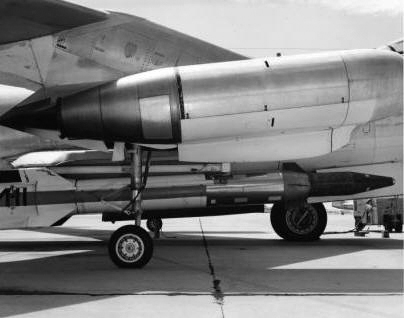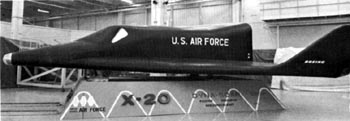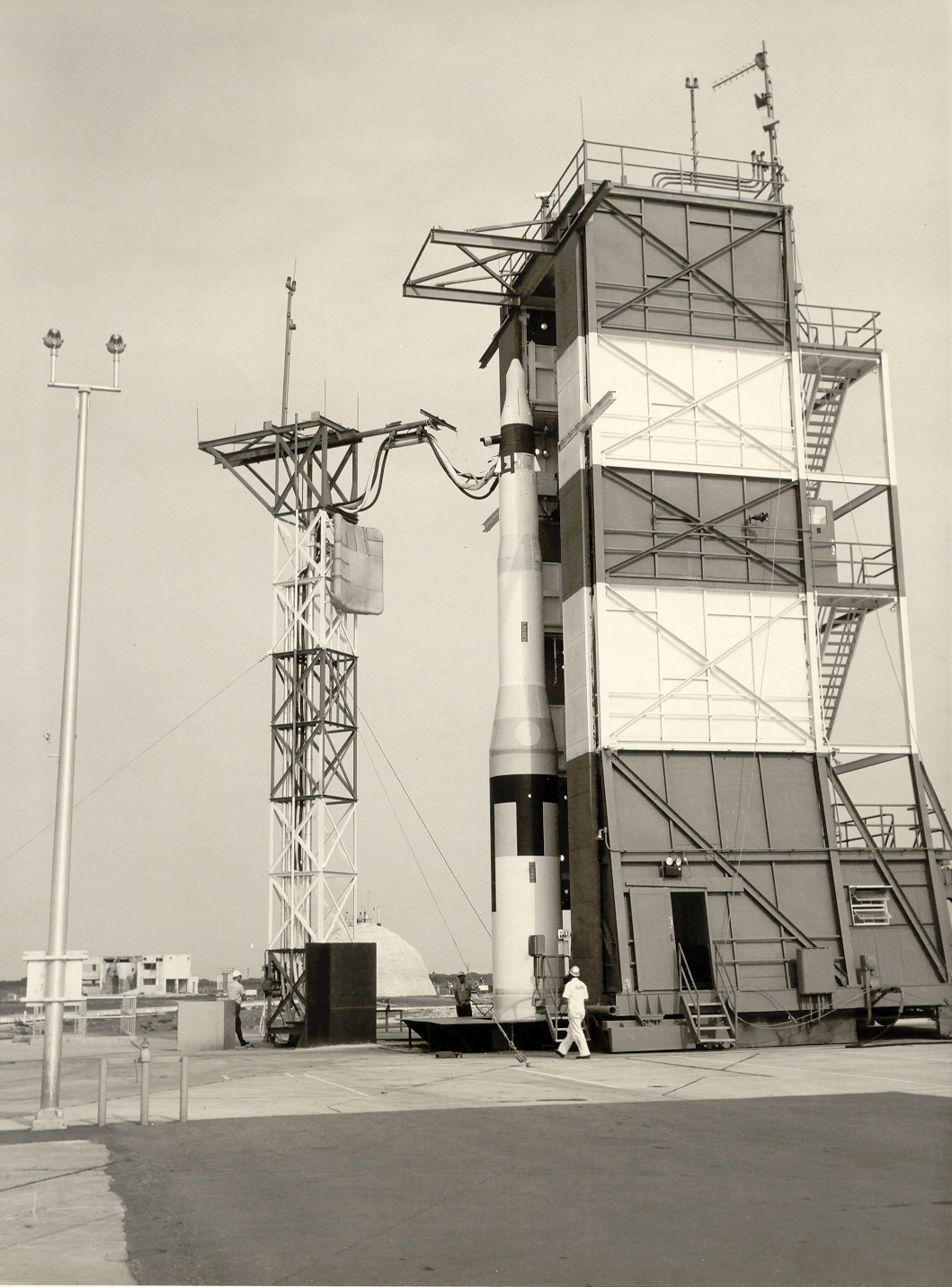|
Alpha Draco
The Alpha Draco missile, also known as Weapons System 199D (WS-199D), was an experimental ballistic missile developed by McDonnell Aircraft in the late 1950s to investigate the aerodynamic physics of the boost-glide reentry trajectory. Three test flights were conducted in 1959, of which two were successful. Design and development As part of the WS-199 project to develop new strategic weapons for the United States Air Force's Strategic Air Command, McDonnell Aircraft developed the Alpha Draco missile between 1957 and 1959, under a contract to launch three vehicles to determine the feasibility of the boost-glide reentry vehicle (BGRV) concept.Brulle 2008, p. 89. The purpose of the rocket was to establish whether a strategic missile using the "boost-glide" principle of propulsion could be practically used.Parsch 2005. The idea had been proposed by Walter Dornberger, who had moved to McDonnell after working for a short time at Bell Aircraft. Dornberger had originally worked on the i ... [...More Info...] [...Related Items...] OR: [Wikipedia] [Google] [Baidu] |
Ballistic Missile
A ballistic missile is a type of missile that uses projectile motion to deliver warheads on a target. These weapons are guided only during relatively brief periods—most of the flight is unpowered. Short-range ballistic missiles stay within the Earth's atmosphere, while intercontinental ballistic missiles (ICBMs) are launched on a sub-orbital flight. These weapons are in a distinct category from cruise missiles, which are aerodynamically guided in powered flight. Unlike cruise missiles, which are restricted to the atmosphere, it is advantageous for ballistic missiles to avoid the denser parts of the atmosphere and they may travel above the atmosphere into outer space. History The earliest form of ballistic missile dates from the 13th century with its use derived from the history of rockets. In the 14th century, the Ming Chinese navy used an early form of a ballistic missile weapon called the Huolongchushui in naval battles against enemy ships.Needham, Volume 5, Part 7, ... [...More Info...] [...Related Items...] OR: [Wikipedia] [Google] [Baidu] |
Theater Ballistic Missile
A theatre ballistic missile (TBM) is any ballistic missile with a range less than , used against targets " in-theatre". Its range is thus between that of tactical and intermediate-range ballistic missiles. The term is a relatively new one, encompassing the former categories of short-range ballistic missile and medium-range ballistic missile. Examples of this type of in-theatre missile are the Soviet RT-15, TR-1 Temp and American PGM-19 Jupiter missile, both from the 1960s. Specific TBMs Specific types of TBMs (current, past and under development) include: * B-611 * BP-12/A * DF-11 * DF-12/M20 * DF-15 * Type 621 * Type 631 * DF-2 * DF-16 * DF-17 * DF-21 ( China) , (Saudi Arabia) * Hadès * Pluton * SE.4200 * SSBS S1 * Agni I * K-15 * Prahaar * Pragati (planned) * Pralay * Pranash (planned) * Prithvi I * Prithvi II * Prithvi III * Shaurya * Agni II * Agni-P * Fateh-110 * Fateh-313 * Fateh Mobin * Naze'at * Qiam 1 * R ... [...More Info...] [...Related Items...] OR: [Wikipedia] [Google] [Baidu] |
Bold Orion
The Bold Orion missile, also known as Weapons System 199B (WS-199B), was a prototype air-launched ballistic missile (ALBM) developed by Martin Aircraft during the 1950s. Developed in both one- and two-stage designs, the missile was moderately successful in testing, and helped pave the way for development of the GAM-87 Skybolt ALBM. In addition, the Bold Orion was used in early anti-satellite weapons testing, performing the first interception of a satellite by a missile. Design and development The Bold Orion missile was developed as part of Weapons System 199, initiated by the United States Air Force (USAF) in response to the U.S. Navy's Polaris program, with funding authorised by the United States Congress in 1957.Yengst 2010, p.37. The purpose of WS-199 was the development of technology that would be used in new strategic weapons for the USAF's Strategic Air Command, not to deliver operational weapons; a primary emphasis was on proving the feasibility of an air-launched ballist ... [...More Info...] [...Related Items...] OR: [Wikipedia] [Google] [Baidu] |
Boeing X-20 Dyna-Soar
The Boeing X-20 Dyna-Soar ("Dynamic Soarer") was a United States Air Force (USAF) program to develop a spaceplane that could be used for a variety of military missions, including aerial reconnaissance, bombing, space rescue, satellite maintenance, and as a space interceptor to sabotage enemy satellites. The program ran from October 24, 1957, to December 10, 1963, cost US$660 million ($ in current dollars), and was cancelled just after spacecraft construction had begun. Other spacecraft under development at the time, such as Mercury or Vostok, were space capsules with ballistic re-entry profiles that ended in a landing under a parachute. Dyna-Soar was more like an aircraft. It could travel to distant targets at the speed of an intercontinental ballistic missile, was designed to glide to Earth like an aircraft under control of a pilot, and could land at an airfield. Dyna-Soar could also reach Earth orbit, like conventional, manned space capsules. These characteristics mad ... [...More Info...] [...Related Items...] OR: [Wikipedia] [Google] [Baidu] |
LGM-30 Minuteman
The LGM-30 Minuteman is an American land-based intercontinental ballistic missile (ICBM) in service with the Air Force Global Strike Command. , the LGM-30G Minuteman III version is the only land-based ICBM in service in the United States and represents the land leg of the U.S. nuclear triad, along with the Trident submarine-launched ballistic missile (SLBM) and nuclear weapons carried by long-range strategic bombers. Development of the Minuteman began in the mid-1950s when basic research indicated that a solid-fuel rocket motor could stand ready to launch for long periods of time, in contrast to liquid-fueled rockets that required fueling before launch and so might be destroyed in a surprise attack. The missile was named for the colonial minutemen of the American Revolutionary War, who could be ready to fight on short notice. The Minuteman entered service in 1962 as a deterrence weapon that could hit Soviet cities with a second strike and countervalue counterattack if the U.S ... [...More Info...] [...Related Items...] OR: [Wikipedia] [Google] [Baidu] |
Hypersonic
In aerodynamics, a hypersonic speed is one that exceeds 5 times the speed of sound, often stated as starting at speeds of Mach 5 and above. The precise Mach number at which a craft can be said to be flying at hypersonic speed varies, since individual physical changes in the airflow (like molecular dissociation and ionization) occur at different speeds; these effects collectively become important around Mach 5-10. The hypersonic regime can also be alternatively defined as speeds where specific heat capacity changes with the temperature of the flow as kinetic energy of the moving object is converted into heat. Characteristics of flow While the definition of hypersonic flow can be quite vague and is generally debatable (especially due to the absence of discontinuity between supersonic and hypersonic flows), a hypersonic flow may be characterized by certain physical phenomena that can no longer be analytically discounted as in supersonic flow. The peculiarity in hypersonic flows ... [...More Info...] [...Related Items...] OR: [Wikipedia] [Google] [Baidu] |
Lift/drag Ratio
In aerodynamics, the lift-to-drag ratio (or L/D ratio) is the lift generated by an aerodynamic body such as an aerofoil or aircraft, divided by the aerodynamic drag caused by moving through air. It describes the aerodynamic efficiency under given flight conditions. The L/D ratio for any given body will vary according to these flight conditions. For an aerofoil wing or powered aircraft, the L/D is specified when in straight and level flight. For a glider it determines the glide ratio, of distance travelled against loss of height. The term is calculated for any particular airspeed by measuring the lift generated, then dividing by the drag at that speed. These vary with speed, so the results are typically plotted on a 2-dimensional graph. In almost all cases the graph forms a U-shape, due to the two main components of drag. The L/D may be calculated using computational fluid dynamics or computer simulation. It is measured empirically by testing in a wind tunnel or in free flight te ... [...More Info...] [...Related Items...] OR: [Wikipedia] [Google] [Baidu] |
Range Safety
In the field of rocketry, range safety may be assured by a system which is intended to protect people and assets on both the rocket range and downrange in cases when a launch vehicle might endanger them. For a rocket deemed to be ''off course'', range safety may be implemented by something as simple as commanding the rocket to shut down the propulsion system or by something as sophisticated as an independent ''Flight Termination System'' (FTS), which has redundant transceivers in the launch vehicle that can receive a command to self-destruct then set off charges in the launch vehicle to combust the rocket propellants at altitude. Not all national space programs use flight termination systems on launch vehicles. Range safety officers or RSOs are also present in the hobby of model rocketry and then are usually responsible for ensuring a rocket is built correctly, using a safe engine/recovery device, and launched correctly. Flight termination Ground controlled termination Some la ... [...More Info...] [...Related Items...] OR: [Wikipedia] [Google] [Baidu] |
MGR-1 Honest John
The MGR-1 Honest John rocket was the first nuclear-capable surface-to-surface rocket in the United States arsenal.The first nuclear-authorized ''guided'' missile was the MGM-5 Corporal. Originally designated Artillery Rocket XM31, the first unit was tested on 29 June 1951, with the first production rounds delivered in January 1953. Its designation was changed to M31 in September 1953. The first Army units received their rockets by year's end and Honest John battalions were deployed in Europe in early 1954. Alternatively, the rocket was capable of carrying an ordinary high-explosive warhead weighing . History and development Developed at Redstone Arsenal, Alabama, the Honest John was a large but simple fin-stabilized, unguided artillery rocket weighing in its initial M31 nuclear-armed version. Mounted on the back of a truck, the rocket was aimed in much the same way as a cannon and then fired up an elevated ramp, igniting four small spin rockets as it cleared the end of the ... [...More Info...] [...Related Items...] OR: [Wikipedia] [Google] [Baidu] |
Flame Deflector
A flame (from Latin ''flamma'') is the visible, gaseous part of a fire. It is caused by a highly exothermic chemical reaction taking place in a thin zone. When flames are hot enough to have ionized gaseous components of sufficient density they are then considered plasma. Mechanism Color and temperature of a flame are dependent on the type of fuel involved in the combustion, as, for example, when a lighter is held to a candle. The applied heat causes the fuel molecules in the candle wax to vaporize (if this process happens in inert atmosphere without oxidizer, it is called pyrolysis). In this state they can then readily react with oxygen in the air, which gives off enough heat in the subsequent exothermic reaction to vaporize yet more fuel, thus sustaining a consistent flame. The high temperature of the flame causes the vaporized fuel molecules to decompose, forming various incomplete combustion products and free radicals, and these products then react with each other and with th ... [...More Info...] [...Related Items...] OR: [Wikipedia] [Google] [Baidu] |
Cape Canaveral Air Force Station Launch Complex 10
Launch Complex 10 (LC-10) at Cape Canaveral Space Force Station, Florida was a launch pad used by SM-64 Navaho missiles, and later Jason sounding rockets and the Alpha Draco The Alpha Draco missile, also known as Weapons System 199D (WS-199D), was an experimental ballistic missile developed by McDonnell Aircraft in the late 1950s to investigate the aerodynamic physics of the boost-glide reentry trajectory. Three test ... research missile. It was located north of Launch Complex 17, where Launch Complexes 31 and 32 are now located. A single Navaho missile was test-launched from LC-10, on 12 August 1957, and was one of only three Navahos to complete a successful flight. Following the cancellation of the Navaho, LC-10 was reused for launches of Jason and Draco sounding rockets during 1958 and 1959. The last launch to use the site was of a Draco on 27 April 1959. LC-10 was subsequently demolished during the construction of Launch Complexes 31 and 32, which were built on the same ... [...More Info...] [...Related Items...] OR: [Wikipedia] [Google] [Baidu] |
Cape Canaveral Air Force Station
Cape Canaveral Space Force Station (CCSFS) is an installation of the United States Space Force's Space Launch Delta 45, located on Cape Canaveral in Brevard County, Florida. Headquartered at the nearby Patrick Space Force Base, the station is the primary launch site for the Space Force's Eastern RangeCAST 1999, p. 1-12. with three launch pads currently active (Space Launch Complexes 37B, 40, and 41). The facility is south-southeast of NASA's Kennedy Space Center on adjacent Merritt Island, with the two linked by bridges and causeways. The Cape Canaveral Space Force Station Skid Strip provides a runway close to the launch complexes for military airlift aircraft delivering heavy and outsized payloads to the Cape. A number of American space exploration pioneers were launched from CCSFS, including the first U.S. Earth satellite (1958), first U.S. astronaut (1961), first U.S. astronaut in orbit (1962), first two-man U.S. spacecraft (1965), first U.S. unmanned lunar lan ... [...More Info...] [...Related Items...] OR: [Wikipedia] [Google] [Baidu] |



_Mach_7_computational_fluid_dynamic_(CFD).jpg)


